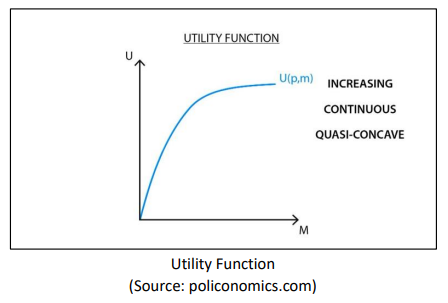Consumer Theory: The Utility Function
- sujonodamario

- May 12, 2021
- 2 min read
According to Advanced Microeconomic Theory by Jehle and Reny (2011), consumer preferences are characterized by five axioms and represented by a binary relation ≿ of two consumption bundles (𝑥1 ≿ 𝑥2 means 𝑥1 is at least as good as 𝑥2). However, this representation is considered ‘primitive’ and fundamental, thus, another way for summarizing this information is needed and it is called a utility function.
The utility function is more applicable mathematically in modern theory without removing any information for the preferences. The following statement is the formal definition of the utility function (based on Advanced Microeconomic Theory (Jehle and Reny, 2011)).

“A real-valued function 𝑢: ℝ+ 𝑛 → ℝ is called a utility function representing the preference relation ≿ if for all 𝑥0, 𝑥1 ∈ ℝ+ 𝑛 , 𝑢(𝑥0 ) ≥ 𝑢(𝑥1) ⟺ 𝑥0 ≿ 𝑥1.” This means that a utility function of preferred bundles would have a higher number compared to less preferred one. The concept of the utility function is based on three theorems
This means that a utility function of preferred bundles would have a higher number compared to a less preferred one. The concept of the utility function is based on three theorems.
Theorem 1. Existence of Real-Valued Function Representing the Preference Relation
“If the binary relation ≿ is complete, transitive, continuous, and strictly monotonic, there exists a continuous real-valued function 𝑢: ℝ+ 𝑛 → ℝ, which represents ≿.”
This means it is always possible to represent a preference relation with at least one continuous function and there may be more than one function.
Theorem 2. Invariance of the Utility Function to Positive Monotonic Transforms
“Let ≿ be a preference relation on ℝ+ 𝑛 suppose 𝑢(𝑥) is a utility function that represents it. Then 𝑣(𝑥) also represents ≿ if and only if 𝑣(𝑥) = 𝑓(𝑢(𝑥)) for every 𝑥, where 𝑓: ℝ → ℝ is strictly increasing on the set of values taken on by 𝑢.”
This theorem simply says that positive monotonic transformation (e.g., linear or logarithmic transformation) of utility function represents the same preference relations as the original utility function.
Theorem 3. Properties of Preferences and Utility Functions
“Let ≿ be represented by 𝑢: ℝ+ 𝑛 → ℝ, then:
u(𝑥) is strictly increasing if and only if ≿ is strictly monotonic
u(𝑥) is quasiconcave if and only if ≿ is convex.
u(𝑥) is strictly quasiconcave if and only if ≿ is strictly convex.
This theorem simply states the mathematical properties of a utility function that applies the five axioms of preference relations.
The utility function is very convenient for microeconomic analysis due to its shape (real-valued functions). It is easy to manipulate and simulate that it provides valuable insights about the consumers’ behavior and their effects on the economy as a whole.




Comments